|
Authentic wine: toward natural and sustainable winemaking
Naturalness is a hot topic in the wine
world. But what exactly is a “natural wine”? For this pioneering book,
best-selling wine writer Jamie Goode has teamed up with winemaker and Master of
Wine Sam Harrop to explore the wide range of issues surrounding authenticity in
wine. They begin by emphasizing that wine’s diversity, one of its strengths,
is currently under threat from increasingly homogenized commercial wines that
lack a sense of place. Drawing on a global array of examples and anecdotes,
Goode and Harrop examine complex concepts—terroir, biodynamics, and
sustainability—in clear language. They also discuss topics including cultured
and wild yeasts, wine “faults,” the carbon footprint of the wine industry,
“natural” as a marketing concept, and more. Authentic Wine illuminates a
subject of great interest to wine producers, consumers, and anyone wondering
where the wine industry is headed. REVIEWS
This is one of the most engaging, thoughtful and enlightening books on contemporary wine to have been published. Winemakers may well be the book’s most immediate audience, but it also offers insights for anyone interested in what they are drinking. And by taking a practical approach to matters that have often been discussed in vague and romantic terms, Goode and Harrop have created a manifesto for an industry looking to shape its future around wine as a natural and sustainable product. Full review here
It may have been a wet and dodgy year for wine but it's been a good year for wine books. The most compelling new book is undoubtedly Authentic Wine by Jamie Goode and Sam Harrop... Buzz terms such as minerality and brettanomyces are dealt with in detail and the authors tackle big questions, such as whether terroir can only be expressed by ''natural'' winemaking combined with biodynamic or organic grape growing. And whether the addition of acid results in homogenous-tasting wines... How valid is it to promote wine as having little or no added sulfur? How wild are wild yeasts? As scientist-cum-wine writer and winemaker, respectively, Goode and Harrop demystify the mumbo-jumbo and make complex technical information digestible. They don't readily swallow the ''touchy-feely'' arguments. They write sense and refrain from being too judgmental. This is an outstanding read. Full review here
The rise of natural wines over the last
five years has provoked one of the most contentious and useful debates in recent
wine history. Though it is a fringe movement, with little organization or no
goal other than producing and enjoying its own wines with as little winemaking
intervention as possible, the power of its ideas has proved highly influential
in the fine-wine industry. What makes wine natural, and what
prevents it from being considered so? The questions embrace the spectrum of
grape-growing and winemaking practices, but can seem befuddling to those not
already schooled in the intricacies of wine production. Enter “Authentic Wine: Toward Natural
and Sustainable Winemaking” by Jamie Goode and Sam Harrop, (University of
California Press, $29.95), which makes a valiant effort to address the questions
raised by the natural challenge in a scientific, dispassionate manner. …Two
things are immediately clear: first, while the authors argue that the wine
industry is best served by using the most-natural methods possible, they also
want to make such methods palatable for commercial wineries, which don’t have
any obvious incentive to overhaul their methods radically. Their sliding scale
of naturalness makes it easier for big companies to claim the mantle. Second,
and most interesting, “Authentic Wine” highlights how much science has yet
to understand about grape-growing and winemaking. The authors cannot
definitively answer questions like what constitutes minerality in wine, whether
wild or cultured yeasts are superior or how wines age. But “Authentic Wine”
performs the invaluable service of raising crucial questions and explaining
complicated issues coherently. Read full review here Robert Parker, The Wine Advocate 'Readers should be aware of a very good book called Authentic Wine: Toward Natural and Sustainable Winemaking, by Dr Jamie Goode, a British wine writer, and coauthored by Sam Harrop, a Master of Wine and winemaker. This is one of the more balanced and detailed accounts dealing with the issue of sustainable winemaking, and idea we all should encourage and support. As the writers suggest, much of the jihadism regarding so-called unregulated and undefined 'natural' or 'naked' wines in in fact misleading, if not intentionally dishonest.' The Wine Advocate, issue 197 Tom Mansell, at www.palatepress.com
Overall, the book does a masterful job of
examining an entire spectrum of issues related to the natural wine movement. It
takes care to look at many sides of each issue and does so rationally and
thoughtfully. One could cynically say, then, that for these reasons, the book
might not make a very big splash among wine consumers. In a culture that is
drawn to extremes on contentious issues, we seem to prefer romanticism and
polemics, while moderate voices that carefully consider the facts are often
overlooked. Indeed, one could draw a parallel to a point made in the book
itself, that novel but questionably effective methods are given more attention
than the hard work of growers and winemakers who use ever increasing scientific
understanding to discover how to best reveal their terroirs in their wines. I
hope the cynic in me is wrong and I hope many, many people will read this book.
It will undoubtedly increase readers’ overall understanding of wine and can
lead to more informed and productive discussions in the “authentic wine”
debate. Full review here
Goode and Harrop originally intended to
title their book Natural Wine. They abandoned that name both because
"natural" in this instance is virtually impossible to define and
because their real concern was something broader than cellar techniques. While
more natural and less industrial winemaking is a direction they endorse, their
real passion is for place--forterroir--for a cornucopia of wines that
reflect their grapes and origins and regions in authentic ways. Beyond the use
or non-use of sulfites and packaged yeast, authenticity for them also involves
sustainable farming and winemaking practices; reasonable (i.e.,
non-stratospheric) ripeness levels; an absence of serious faults; and a concern
for environmental issues and wine's carbon footprint. The book includes detailed but entirely
readable technical overviews of issues in the controversy about what is and is
not "natural": vines grafted onto specialized rootstocks versus vines
on their own roots; the role of sulfur dioxide; wild versus cultivated
commercial yeast; the wonderful world of enzymes, filtration, and so on. A
substantial chapter looks into common wine faults, where they come from, what
can be done about them, and how much of any "fault" is really a fault.
For anyone who wants to understand the innards of these issues, this book is a
fine place to start. In between the authors' treatments of
wine production issues are long sections of interviews with growers and
winemakers who are experimenting with more natural / less chemical
methods--spontaneous fermentations, avoidance of sulfites, and vineyard
management without herbicides and pesticides. The authors and their informants
are not always on the same page, which makes the book all the more interesting;
the chapter which includes enthusiastic reports from several biodynamic grape
growers, for example, also summarizes scientific research indicating that
biodynamics does nothing to improve wine quality. Rather than providing simple answers,
most of the discussions pose interesting questions. A whiff of barnyardy
Brettanomyces, for example, might improve a wine for some tasters; but a lot of
wines with significant Brett levels all end up tasting the same. Lowering the
alcohol of a finished wine with reverse osmosis, a fancy form of filtration,
seems like the ultimate manipulation. But what if a grower gets caught by late
season heat spikes, which run up the sugar, which runs up the alcohol; and what
if lowering it back down helps the wine reveal its place of origins much better? Overall, the book is quite pragmatic,
realistic, balanced and informative. It's not a polemic; indeed, Goode and
Harrop criticize the more ardent naturalistas at several points for adopting a
hard ideological tone that simply drives most of the industry away. The authors
are perfectly passionate about the fate of wine, but more interested in what
kinds of improvements can be made than in some set of doctrines that have to be
followed. Full review
here
It's an emblematic wine-world row. Wine made on "natural" principles - both with organically or biodynamically grown grapes and with minimal intervention in the winery - makes up little more than a thimbleful of the total on sale. Yet its proponents are passionate - and they articulate a wider unease among winemakers and critics about the steady homogenisation of wine. Amid this controversy's sound and fury, Jamie Goode and Sam Harrop's Authentic Wine: Toward Natural and Sustainable Winemaking (University of California Press, £20.95) offers an admirably cool and authoritative analysis. They argue that we are "at a crossroads in the history of wine" because of steady commercialisation and the spread of methods such as adding grape juice concentrate to get sweeter wines. They are supporters of natural wine as a counterweight to such trends, with its emphasis on hard work in the vineyard, small-scale techniques and minimising the use of chemicals, notably sulphur dioxide. Yet they are not partisan. They readily concede that overall wine quality has improved in recent years. And they prefer the term "authentic" to natural - wine with a clear sense of what US critic Matt Kramer calls "somewhereness", reflecting a particular terroir, as opposed to the bland "nowhereness" of the big brands. It's a serious book covering serious technical issues (Goode is a former science editor and Harrop a Kiwi winemaker) but it does so in a way that is very accessible without being patronising. Full review here
“This book has me nodding my head in
agreement and shaking it occasionally in latent debate all the way through –
which probably means it’s hit the mark for the authors. It’s a persuasive
read in a calm, eminently readable style which makes the complex subjects hugely
approachable and comprehensible. Given
the importance of these subjects, that is great work. I can envisage
readily-thumbed volumes of this sitting on the bookshelves of wine enthusiasts
and professionals alike.” Full review here Mike Veseth, on wineeconomist.com “The wine industry is at a
crossroads,” write Jamie Goode and Sam Harrop in the concluding chapter of
their fine new book, Authentic Wine. “Wine is a wonderful natural, authentic
product. Do we emphasize this naturalness, celebrate the diversity of wine, and
put our house in order by steering away from unneeded additions and
manipulations? Or do we allow wine to become simply another manufactured
beverage whose flavours are manipulated to match perceived consumer
preferences?” Thus do Goode and Harrop state what I
have come to call the Terroirist Manifesto. It is pretty clear, when you put it
this way, that our only choice is to take up arms in defense of natural,
authentic wine. Going down the other road is unthinkable (and perhaps
undrinkable)… …At the end of the day it is pretty
hard to argue with the idea of Authentic Wine as presented here. This is partly
because Goode and Harrop make such a strong case, but it is also because in
“authentic wine” they have created a flexible concept that is narrow when
they want it to be and loose when that’s what’s needed — along with a map
for consumers and producers to
follow so they can enjoy the benefits of authenticity without tears or fears. Go to the fork in the road … and take
it! I think it’s a step in the right direction. Full review: here Jancis Robinson in the Financial
Times, and at jancisrobinson.com I learnt a humbling amount from Goode and
Harrop's clearly written book, however, and by no means all of it scientific. I
didn't realise until they reported the fact from California hi-tech wine
scientist Clark Smith that so few wine-related patents had ever been taken out:
150. I also enjoyed the comments of Foster's Australian winemaker and Master of
Wine Justin Knock on quite how common it is to add sweetening (plain old sugar
in Marlborough Sauvignon Blanc until 2009 when the EU insisted on grape juice
concentrate) to finished wine in commercial blends - particularly from the likes
of Hardys, McGuigan and Yellow Tail (whose soaraway success in the US was surely
predicated on its exceptionally high sugar levels) but much less so for Jacob's
Creek, McWilliams and Yalumba's wines. I am also glad to have discovered that
there is a way of telling whether a wine producer has added water to their wine
(stable isotope analysis, of course, silly). Full review here The Kitchn.com Another book on the 'hot' topic of natural wine. Less of a personal journey and more of a thorough, detailed analysis about what constitutes a natural wine. The authors explore sustainable, organic and biodynamic practices in relation to natural wine, why and how winemakers 'intervene" in the process, as well as looking at the whole 'natural wine movement'. A very well written and useful book with a long shelf life. Once read, it is one to dip in and out of regularly. Review here New book released September 2011
|
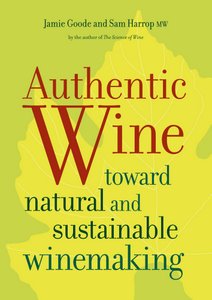
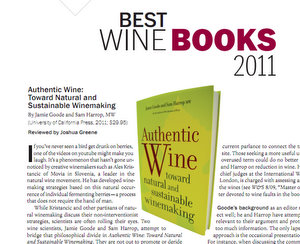 Joshua Greene,
Joshua Greene, 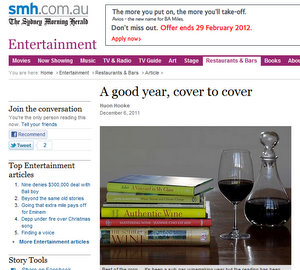 Huon
Hooke, Sydney Morning Herald
Huon
Hooke, Sydney Morning Herald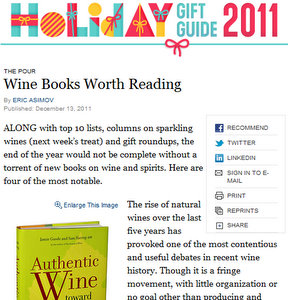 Eric
Asimov, The New York Times
Eric
Asimov, The New York Times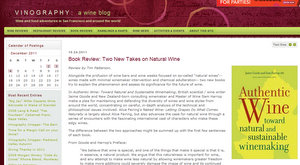 Tim Patterson, at
Tim Patterson, at 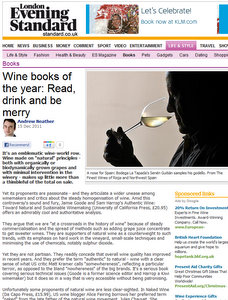 Andrew
Neather in The London Evening Standard
Andrew
Neather in The London Evening Standard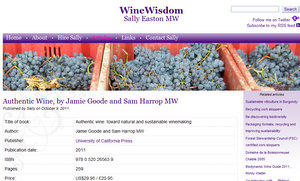 Sally Easton MW, on winewisdom.com
Sally Easton MW, on winewisdom.com (Amazon
UK)
(Amazon
UK)